A Wingwatcher's Guide to Dragons: Difference between revisions
>Platypus the SeaWing No edit summary |
>Platypus the SeaWing mNo edit summary |
||
| Line 79: | Line 79: | ||
* The existence of this scroll confirms that a Wingwatcher's job is to be on the lookout for dragons approaching or attacking scavenger settlements, and possibly fight them off if need be. | * The existence of this scroll confirms that a Wingwatcher's job is to be on the lookout for dragons approaching or attacking scavenger settlements, and possibly fight them off if need be. | ||
[[Category:Scrolls]] | [[Category:Scrolls]] | ||
[[Category: | [[Category:Human History]] | ||
Revision as of 17:15, 2 July 2020
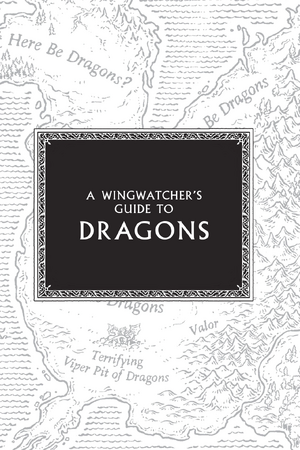
A Wingwatcher's Guide to Dragons is a scroll written by scavengers, presumably the Wingwatchers of Valor. It is included at the beginning of Dragonslayer in a similar manner to the inclusion of A NightWing Guide to the Dragons of Pyrrhia at the beginning of the books of the first and second arcs and A Guide to the Dragons of Pantala at the beginning of the books of the third arc. The dragon illustrations are drawn by Joy Ang. It is a scroll accessible to scavengers through libraries, and copies have been found in Valor. It is the first known scroll published by scavengers to have a title.
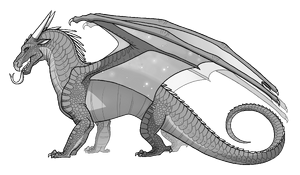
Description:
Purplish-black scales and scattered silver scales like a night sky full of stars; forked black tongues.
Abilities:
Can breathe fire, disappear into dark shadows.
Habitat:
Unknown
Watch Out For:
These rarely seen dragons could be mutations of other types or a nearly extinct species; probably not very important.
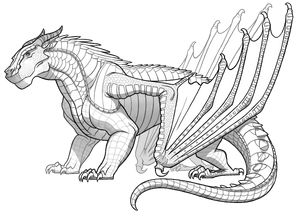
Description:
Thick, armored brown scales, sometimes with amber and gold underscales; large flat heads with nostrils on top of the snout.
Abilities:
Can breathe fire, hold their breath for up to an hour, blend into large mud puddles.
Habitat:
The swamps, marshes, and boiling mud pools between the mountains and the sea.
Watch Out For:
Often found hiding under the mud; also their teeth, claws, fire, the usual.
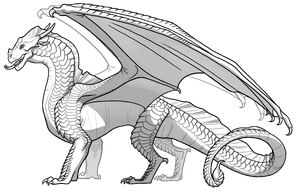
Description:
Pale gold or white scales the color of desert sand; forked black tongues.
Abilities:
Can survive a long time without water, poison prey with the tips of their tails like scorpions, bury themselves for camouflage in the desert sand, breathe fire.
Habitat:
The vast desert west of the forest.
Watch Out For:
Their venomous barbed tails, their teeth, claws, fire.
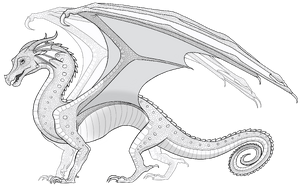
Description:
Scales that can shift colors, usually bright like birds of paradise; prehensile tails.
Abilities:
Can camouflage their scales to blend into their surroundings; rumor has it they can also shoot venom from their fangs.
Habitat:
The mysterious impenetrable rainforest, east of the mountains.
Watch Out For:
We have no idea! No recorded survivor encounters, so they're probably the deadliest and stealthiest of all dragons.

Description:
Silvery scales like the moon or pale blue like ice, ridged claws to grip the ice, forked blue tongues; tails narrow to a whip-thin end.
Abilities:
Can withstand subzero temperatures and bright light; exhale a deadly freezing frostbreath.
Habitat:
The icy arctic region of the upper northwest peninsula, we think.
Watch Out For:
Their breath, which can freeze a human solid; also their teeth and claws.
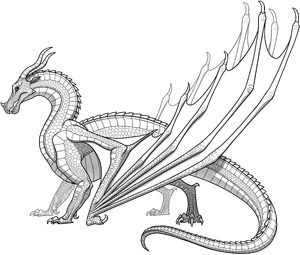
Description:
Red-gold or orange scales, enormous wings.
Abilities:
Powerful fighters and fliers; can breathe fire.
Habitat:
The central mountain range.
Watch Out For:
The way they swoop out of nowhere at high speed, also their teeth, claws, fire.
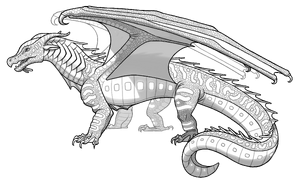
Description:
Blue or green or aquamarine scales; webs between their claws; gills on their necks; glow in the dark stripes on their tails, snouts, underbellies.
Abilities:
Can breathe underwater, create huge waves with the splash of their powerful tails.
Habitat:
The ocean, but possibly also large lakes and rivers.
Watch Out For:
Swimming in any large body of water, also, of course, their teeth and claws (but on the plus side, no fire!)
Trivia
- This is the first known book or scroll published by scavengers to have a title.
- The existence of this scroll confirms that a Wingwatcher's job is to be on the lookout for dragons approaching or attacking scavenger settlements, and possibly fight them off if need be.